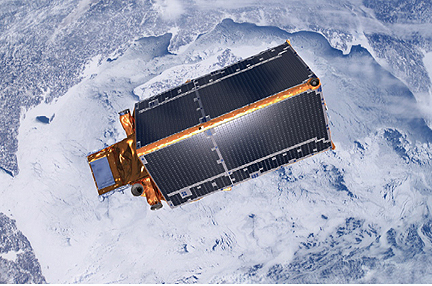This milestone marks the start of the satellite's operational life delivering ice-thickness data to understand the impact of climate change on the polar environment. The handover ceremony took place on November 19th at ESA's European Space Research and Technology Centre (ESTEC) in the Netherlands, where the responsibility for the mission passed from CryoSat-2's Project Manager, Richard Francis, to the Mission Manager, Tommaso Parrinello. Richard Francis had held the mission's reins since the decision was taken to rebuild CryoSat in 2006 following the loss of the original satellite during launch. However, his experience with the mission goes right back to 1999, when CryoSat was selected as an Earth Explorer mission and he worked as the System Manager.
 Launched in April, the mission has recently completed commissioning — an important phase that ensures the satellite, instruments, data retrieval and data processing procedures are in optimal working order. Now that this period is over, the mission has entered its exploitation phase and will start delivering vital data on ice thickness to the scientific community. Tommaso Parrinello now holds the 'keys' to the mission and takes charge of the data exploitation, which is managed from ESRIN, ESA's Centre of Earth Observation in Frascati, Italy. His responsibility includes operations and maintenance, data processing and delivery. The satellite will continue to be monitored, operated and controlled by the Flight Operations Segment at ESA's European Space Operations Centre (ESOC) in Darmstadt, Germany.
Launched in April, the mission has recently completed commissioning — an important phase that ensures the satellite, instruments, data retrieval and data processing procedures are in optimal working order. Now that this period is over, the mission has entered its exploitation phase and will start delivering vital data on ice thickness to the scientific community. Tommaso Parrinello now holds the 'keys' to the mission and takes charge of the data exploitation, which is managed from ESRIN, ESA's Centre of Earth Observation in Frascati, Italy. His responsibility includes operations and maintenance, data processing and delivery. The satellite will continue to be monitored, operated and controlled by the Flight Operations Segment at ESA's European Space Operations Centre (ESOC) in Darmstadt, Germany.
CryoSat is Europe's first mission dedicated to monitoring Earth's ice fields. The satellite carries a sophisticated radar altimeter that can measure the thickness of sea ice down to centimetres and also monitor changes in ice sheets, particularly around the edges where icebergs are calved from the vast ice sheets that cover Greenland and Antarctica. Along with information on ice extent, these measurements on ice-thickness change will show how the volume of Earth's ice is changing and ultimately lead to a better understanding of the relationship between ice and climate change.

